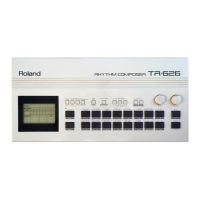# Data
set
1
*The
size of the requested data does not indicate the number
of bytes that
will
make up a DT! message, but represents
the address fields where the requested data resides.
* Some models are subject to limitations
in
data format used
for a single transaction. Requested data, for example, may
have a
limit
in
length or must be divided into predetermined
address fields before
it
is
exchanged across the interface.
*
The
same
number of bytes comprises address and size data,
which, however, vary with the Model-
ID.
* The error checking process uses a checksum that provides
a
bit
pattern where the least significant 7 bits are zero when
values
for
an address, size, and that checksum are summed.
DT1
(12H)
This message corresponds to the actual data transfer process.
Because every byte
in
the data
is
assigned a unique address,
a DT! message can convey the starting address of one or
more
data
as well as a series of data formatted
in
an
address
- dependent order.
The
MIDI
standards inhibit non - real time messages from
interrupting
an
exclusive one. This fact
is
inconvenient for the
devices that support a
"soft-through"
mechanism. To maintain
compatibility with such devices, Roland has limited the DTI to
256 bytes so that an
excessive!}'.
long message
is
sent out
in
separate segments.
Byte Description
F0H
Exclusive
41H
Manufactures
ID
(Roland)
DEV
Device
ID
MDL
Model
ID
12H
Command
ID
aaH Address
MSB
LSB
ddH
Data
:
:
:
:
sum Check sum
F7H
End
of exclusive
*A
DT! message
is
capable of providing only the valid data
among those specified by an RQ! message.
*Some models are subject· to limitations
in
data format used
for a single transaction. Requested data, for example, may
have a limit
in
length or must be divided into predetermined
address fields before it
is
exchanged across the interface.
*The
number of bytes comprising address data varies from
one
Model
-
ID
to another.
>i<The
error checking process uses a checksum that provides
a bit pattern where the least significant 7 bits are zero when
values for
an
address,
size,
and
that checksum are summed.
# Example
of
Message Transactions
• Device A sending data to Device B
Transfer of a DT! message
is
all that takes place.
j Device (A) l
j Device (B) j
[Data
set
1]
* More than 20m
sec
time internal.
[Data
set
1]
[Data
set
1]
• Device B requesting data from Device A
Device B sends an
RQ!
message to Device
A.
Checking the
message, Device A sends a DT! message back
to
Device
B.
I Device (A) l l Device (B) l
[Data
set
1]
-1----------1.Request
data]
[Data
set
1 J
* More
than
20m
sec
time internal.
[Data
set
1 J
[Data
set
1]
91Handshake-
Transfer Procedure!
Handshaking
is
an
interactive process where two devices
exchange error checking signals before a message transaction
takes place, thereby increasing
data
reliability. Unlike
one-way
transfer that inserts a
pause
between
message
transactions,
handshake transfer allows much speedier transactions because
data transfer starts once the receiving device returns a ready
signal.
When
it
comes to handling large amounts of
data-
-sampler
waveforms and synthesizer tones over the entire range, for
example-
-across
a
MIDI
interface, handshaking transfer
is
more efficient than
one-way
transfer.
Types
of
Messages
Message
Command
ID
Want
to
send
data
WSD
(40H)
Request
data
ROD
(41
H)
Data
set
DAT
(42H)
Acknowledge
ACK
(43H)
End
of
data
EOD
(45H)
Communication
error
ERR
(4EH)
Rejection RJC (4FH)
# Want
to
send data : WSD (40H)
This message
is
sent out when data must be sent to a device
at the other end of the interface. It contains data for the
address
and
size that specify designation and length ,
respectively, of the data to be sent.
On
receiving a
WSD
message, the remote device checks its
memory for the specified data address and size which
will
satisfy the request.
If
it
finds them and is ready for
communication, the device will return
an
"Acknowledge
(ACK)" message.
Otherwise,
it
will
return a "Rejection (RJC)" message. ·
Byte Description
F0H
Exclusive
status
41H
Manufactures
ID
(Roland)
DEV
Device
ID
MDL
Model
ID
40H
Command
ID
aaH Address
MSB
LSB
ssH Size
MSB
LSB
sum
Check sum
F7H
End
of
exclusive
*The
size of the data to be sent does not indicate the number
of bytes that make up a "Data set (DAT)" message, but
represents the address fields where the data should reside.
*Some models are subject to limitations
in
data format used
for a single transaction. Requested data,
for
example, may
have a limit
in
length or must be divided into predetermined
address fields before
it
is
exchanged across the interface.
*The
same number of bytes comprises address and size data,
which, however, vary with the
Model-
ID.
*The
error
checking process uses a checksum that provides
a
bit
pattern where the least significant 7 bits are zero when
values for an address,
size,
and that checksum are summed.
109

